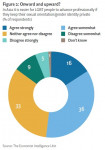Indonesia gears up for healthcare breakthrough, but tough obstacles remain in the way
Old problems, fresh solutions: Indonesia’s new health regime, an Economist Intelligence Unit report sponsored by GE, analyses these challenges and their potential solutions, and puts them in context through interviews with government, medical and academic experts in Indonesia. It also highlights how innovations in developing countries elsewhere may provide solutions to some of Indonesia’s most pressing healthcare challenges. The key findings of the report include:
· Healthcare inequality is a key challenge. Indonesia’s island geography makes extending healthcare services to rural regions even more challenging than it is in other countries. The urban-rural divide is extreme: while in 2006 urban areas had one doctor for every 2,763 inhabitants, in rural regions the ratio was one for every 16,792 people. Consequently, health outcomes in rural regions are much worse. The relative poverty of rural residents also makes them more vulnerable to catastrophic healthcare costs when disease or disaster strikes.
· Healthcare spending is low, and out-of-pocket spending accounts for a high proportion. Scarce insurance coverage and the high proportion of healthcare costs borne directly by patients account for the fact that healthcare spending as a whole in Indonesia is among the lowest in the region. Vietnam, India and Cambodia all have lower per-capita incomes than Indonesia yet spend more per person on healthcare services. Of the money that is spent in Indonesia, only around half comes from the government, with a third paid directly by the people themselves in out-of-pocket payments, and the rest from insurance schemes, foreign aid and other sources.
· Meeting Millennium Development Goals means improving healthcare finance and services. The government remains committed to achieving its Millennium Development Goals (targets for basic development issues like sanitation, improved maternal mortality rates and schooling) and is making substantial increases to its health budget in coming years, as well as rolling out health insurance to many people who lack coverage. But services also need to be improved. An uneven distribution of medical staff is an acute problem: rural regions lack general practitioners and specialists such as gynecologists, obstetricians, endocrinologists and anesthetists. The government is incentivising the migration of doctors away from the big cities but schemes have yet to make a meaningful impact.
· More focus on prevention is required. Investment in infrastructure as basic as water supply and sanitation, in addition to building hospitals, is vital, but some experts suggest local governments do not always make the best use of funds. Thanks to decentralisation, these authorities now wield large spending power but are still developing the skills they need to administer their budgets. Often, focusing on prevention— particularly education about family planning and nutrition (and more “lifestyle” issues related to smoking and heart disease)—would bring greater benefits than building landmark facilities. The role of the private sector in making efficient use of funds could also be expanded.
· “Frugal innovation” may help. Innovations to reduce the cost of healthcare technology and expand its reach could be the key to helping Indonesia surmount its healthcare challenges. Commonly thought of as the preserve of rich, technologically-advanced nations, these days groundbreaking innovations often come from developing countries facing similar challenges to those Indonesia must address. This paper highlights three examples of such “frugal innovation”: the Breath of Life programme in Vietnam, which has helped halve the cost of life-saving respiratory machinery for newborns; Devi Shetty’s landmark heart hospital in Bangalore, which uses economies of scale to drive down costs; and the use of telemedicine to link doctors in urban areas to isolated rural communities in Bangladesh, as promoted by Muhammad Yunus of Grameen Bank.
About the Economist Intelligence Unit
The Economist Intelligence Unit is the business information arm of The Economist Group, publisher of The Economist. Through our global network of more than 650 analysts and contributors, we continuously assess and forecast political, economic and business conditions in more than 200 countries. As the world's leading provider of country intelligence, we help executives make better business decisions by providing timely, reliable and impartial analysis on worldwide market trends and business strategies. For more information, please visit www.eiu.com or follow us on www.twitter.com/theeiu
웹사이트: http://www.eiu.com
연락처
Joanne McKenna
press liaison
+44 (0)20 7576 8188
이메일 보내기
이 보도자료는 Economist Intelligence Unit가(이) 작성해 뉴스와이어 서비스를 통해 배포한 뉴스입니다.




